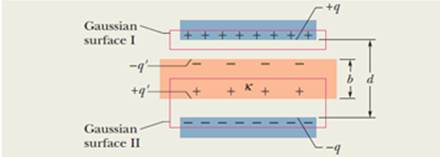
Concept explainers
For the arrangement of Fig. 25-17, suppose that the battery remains connected while the dielectric slab is being introduced. Calculate (a) the capacitance, (b) the charge on the capacitor plates, (c) the electric field in the gap, and (d) the electric field in the slab, after the slab is in place.

Figure 25-17A parellel-plate capacitor containing a dielectric slabthat only partially fills the space between the plates.
Want to see the full answer?
Check out a sample textbook solution
Chapter 25 Solutions
WILEY PLUS ACCESS CODE
Additional Science Textbook Solutions
Campbell Essential Biology with Physiology (5th Edition)
Chemistry: The Central Science (14th Edition)
Laboratory Experiments in Microbiology (12th Edition) (What's New in Microbiology)
Biology: Life on Earth with Physiology (11th Edition)
College Physics: A Strategic Approach (3rd Edition)
Campbell Biology in Focus (2nd Edition)
- A parallel-plate capacitor with capacitance 5.0F is charged with a 12.0-V battery, after which the battery is disconnected. Determine the minimum work required to increase the separation between the plates by a factor of 3.arrow_forwardWhat is the maximum charge that can be stored on the 8.00-cm2 plates of an air-filled parallel-plate capacitor beforebreakdown occurs? The dielectric strength of air is 3.00 MV/m.arrow_forwardCheck Your Understanding The radius of the outer sphere of a spherical capacitor is five times the radius of its inner shell. What are the dimensions of this capacitor if its capacitance is 5.00 pF?arrow_forward
- The dielectric to be used in a parallel-plate capacitor has a dielectric constant of 3.60 and a dielectric strength of 1.60107 V/m. The capacitor has to have a capacitance of 1.25 nF and must be able to withstand a maximum potential difference 5.5 kV. What is the minimum area the plates of the capacitor may have?arrow_forwardCheck Your Understanding The potential difference across a 5.0-pF capacitor is 0.40 V. (a) What is the energy stored in this capacitor? (b) The potential difference is now increased to 1.20 V. By what factor is the stored energy increased?arrow_forward(i) Rank the following five capacitors from greatest to smallest capacitance, noting any cases of equality, (a) a 20-F capacitor with a 4-V potential difference between its plates (b) a 30-F capacitor with charges of magnitude 90 C on each plate (c) a capacitor with charges of magnitude 80 C on its plates, differing by 2 V in potential. (d) a 10-F capacitor storing energy 125 J (e) a capacitor storing energy 250 J with a 10-V potential difference (ii) Rank the same capacitors in part (i) from largest to smallest according to the potential difference between the plates, (iii) Rank the capacitors in part (i) in the order of the magnitudes of the charges on their plates, (iv) Rank the capacitors in part (i) in the order of the energy they store.arrow_forward
- (a) Regarding (lie Earth and a cloud layer 800 m above the Earth as the plates of a capacitor, calculate the capacitance of the Earth-cloud layer system. Assume the cloud layer has an area of 1.00 km2 and the air between the cloud and the ground is pure and dry'. Assume charge builds up on the cloud and on the ground until a uniform electric field of 3.00 106 N/C throughout the space between them makes the air break down and conduct electricity as a lightning bolt, (b) What is the maximum charge the cloud can hold?arrow_forwardWhat If? The two capacitors of Problem 13 (C1 = 5.00 F and C2 = 12.0 F) are now connected in series and to a 9.00-Y battery. Find (a) the equivalent capacitance of the combination. (b) the potential difference across each capacitor, and (c) the charge on each capacitor.arrow_forwardA particle with charge 1.60 1019 C enters midway between two charged plates, one positive and the other negative. The initial velocity of the particle is parallel to the plates and along the midline between them (Fig. P26.48). A potential difference of 300.0 V is maintained between the two charged plates. If the lengths of the plates are 10.0 cm and they are separated by 2.00 cm, find the greatest initial velocity for which the particle will not be able to exit the region between the plates. The mass of the particle is 12.0 1024 kg. FIGURE P26.48arrow_forward
- An air-filled parallel-plate capacitor with capacitance C0 stores charge Q on plates separated by distance d. The potential difference across the plates is V0 and the energy stored is PEC,0. If the capacitor is disconnected from its voltage source and the space between the plates is then filled with a dielectric of constant = 2.00, evaluate the ratios (a) Cnew/C0, (b) Vnew/V0, and (c) PEC,new/PEC,0.arrow_forwardCheck Your Understanding Repeat the calculations of Example 8.10 for the case in which the battery remains connected while the dielectric is placed in the capacitor.arrow_forwardFind an expression for the electric field between the two conducting disks in Figure P27.61. Make sure your expression is general enough to include the possibility of a dielectric between the disks. Check your answer using the information given in Section 27-8. Figure P27.61arrow_forward
 College PhysicsPhysicsISBN:9781285737027Author:Raymond A. Serway, Chris VuillePublisher:Cengage Learning
College PhysicsPhysicsISBN:9781285737027Author:Raymond A. Serway, Chris VuillePublisher:Cengage Learning Physics for Scientists and Engineers with Modern ...PhysicsISBN:9781337553292Author:Raymond A. Serway, John W. JewettPublisher:Cengage Learning
Physics for Scientists and Engineers with Modern ...PhysicsISBN:9781337553292Author:Raymond A. Serway, John W. JewettPublisher:Cengage Learning
 Principles of Physics: A Calculus-Based TextPhysicsISBN:9781133104261Author:Raymond A. Serway, John W. JewettPublisher:Cengage Learning
Principles of Physics: A Calculus-Based TextPhysicsISBN:9781133104261Author:Raymond A. Serway, John W. JewettPublisher:Cengage Learning Physics for Scientists and Engineers, Technology ...PhysicsISBN:9781305116399Author:Raymond A. Serway, John W. JewettPublisher:Cengage Learning
Physics for Scientists and Engineers, Technology ...PhysicsISBN:9781305116399Author:Raymond A. Serway, John W. JewettPublisher:Cengage Learning College PhysicsPhysicsISBN:9781305952300Author:Raymond A. Serway, Chris VuillePublisher:Cengage Learning
College PhysicsPhysicsISBN:9781305952300Author:Raymond A. Serway, Chris VuillePublisher:Cengage Learning





